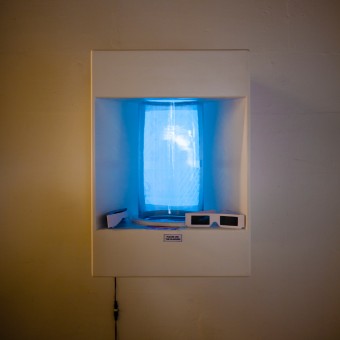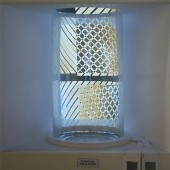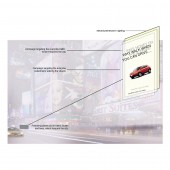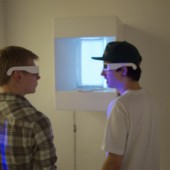Steganography Advertising Concept by Tony Hughes |
Home > Winners > #23742 |
 |
|
||||
| DESIGN DETAILS | |||||
| DESIGN NAME: Steganography PRIMARY FUNCTION: Advertising Concept INSPIRATION: Steganography – as this is the ability to carefully conceal a message within artwork and pre-dates cryptography and modern approaches of hiding messages. UNIQUE PROPERTIES / PROJECT DESCRIPTION: I have used polarising film and wavelengths of light that I hope give a captivating and new approach to advertising and media. This was my final major project before my graduation and I wanted an exciting and daring concept, which at the same time was commercially practical. I also realised from the start the potential for “eye candy branding” and target audience marketing for shop front facades, partitions etc. For example my idea could be used on a billboard where two campaigns could be run from a single billboard space, targeting both audiences in slightly different ways, for example a car company advertises a new car with a strap line aiming its marketing towards pedestrians, while the same billboard could run a slightly different strap line with marketing in mind of people using public transport better capturing the target audience. The approach would be that the bus, train or taxi would have a window covered in the polarising film, which would interact when in line of sight of the polarising signage strap line on the billboard poster. OPERATION / FLOW / INTERACTION: I designed this project with narrative in mind from the perspective of graphic design and also completing my HND in Graphic Design but I truly believed that it was an attractive application, which has commercial value. It is also suitable for landmarks and other subtle signage, which could help visually impaired people, navigate places around the city. It could also be used by shopping centres wanting to add type to windows with subliminal marketing, or just creative advertising. The box was really a commercial prototype for much more exciting ideas which weren’t feasible while finishing off my education. The box works by the design applied to the glass cylinder in the box, but can only be seen through a polarising filter. A demonstration is shown by the two boys wearing glasses, looking at the design on the glass tube. One of the photos shows an example of this working when I held the glasses up to the camera lens and took a photograph looking at the glass cylinder. PROJECT DURATION AND LOCATION: I started this project on the 23rd of February 2011 and completed the final layout on the 28th of May 2011, at the Matthew Bolton College in Birmingham. U.K. FITS BEST INTO CATEGORY: Idea and Conceptual Design |
PRODUCTION / REALIZATION TECHNOLOGY: Polarising Plastic Glass Clear Tape MDF Box Battery powered motor - turn platter. Electroluminescence Sheet SPECIFICATIONS / TECHNICAL PROPERTIES: 60x40cm Box, featuring 20cm Diameter Glass vase, (but this was only due to cost constraints on a student budget.) TAGS: Graphic Design, Creative Design, Steganography, Installation, Advertising, Creative Marketing, Marketing RESEARCH ABSTRACT: Graphic design as I was once taught is about making communication visual. I have always wanted to have an impact on visual communication and this was the reason for researching how we currently advertise and ways to improve on the existing static billboard advertising campaigns. Installation Piece / Proof of concept. This is a form of advertising that has the engaging feature to be invisible, except to the target viewing audience. It has the ability in its final development / production stage to have many commercial applications, including landmarks and for example signs for visually impaired people. I feel it would also be hugely successful in billboard and signage campaigns. CHALLENGE: The hardest part of my design was the challenge of mechanics, making the object move, I believed in the process of polarising light, and wavelengths, what I wasn't confident in was the final layout. I really became captivated by this idea and wasn't able to let it go. ADDED DATE: 2011-06-09 17:49:26 TEAM MEMBERS (1) : A solo project from start to finish. I did have the help of a skilled carpenter to make my design blueprint of the box into a reality. IMAGE CREDITS: Tony Hughes, 2011. |
||||
| Visit the following page to learn more: http://www.tonyhughesdesign.com | |||||
| CLIENT/STUDIO/BRAND DETAILS | |
 |
NAME: Tony Hughes Design PROFILE: Freelance Graphic Designer / Creative. www.tonyhughesdesign.com info@tonyhughesdesign.com |
| AWARD DETAILS | |
 |
Steganography Advertising Concept by Tony Hughes is Winner in Idea and Conceptual Design Category, 2011 - 2012.· Read the interview with designer Tony Hughes for design Steganography here.· Press Members: Login or Register to request an exclusive interview with Tony Hughes. · Click here to register inorder to view the profile and other works by Tony Hughes. |
| SOCIAL |
| + Add to Likes / Favorites | Send to My Email | Comment | Testimonials | View Press-Release | Press Kit |
Did you like Tony Hughes' Idea Design?
You will most likely enjoy other award winning idea design as well.
Click here to view more Award Winning Idea Design.







